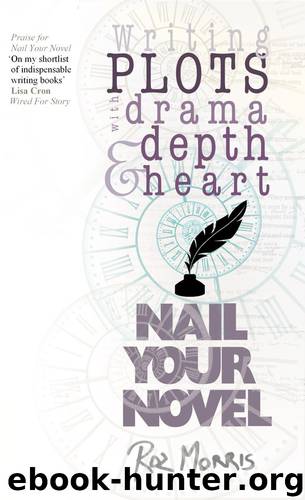Writing Plots With Drama, Depth and Heart: Nail Your Novel by Roz Morris

Author:Roz Morris [Morris, Roz]
Language: eng
Format: epub, mobi
Tags: Writing, Writing Skills, Fiction, Reference, Research & Publishing Guides
Published: 2015-01-05T08:00:00+00:00
10 PACE – THE STORYTELLER’S SPELL
A well-paced story is like an act of hypnosis. It has a travelling beat that takes charge of the reader’s attention. It proceeds at just the right speed to trap them a little longer, beg them to turn another page. And this has nothing to do with the length of the book. Very long novels can gallop away with us because time flies when we’re reading them.
This spell is cast by careful pacing – by creating a sense of tension and change. Just as the overall structure provides the story’s major turning points, the pace keeps the reader hooked second by second.
You might assume pace is only a concern in fast-moving plots, such as thrillers. Not so. Every story will benefit if it is written with an awareness of pace; even a leisurely character journey.
Indeed, pace is a fundamental in most artforms – not just storytelling. If you’re making a video, you want a change at least every fifteen seconds. The change might be subtle, such as fading a colour, or panning a picture so the view reveals more. Or it might be obvious, such as switching to a different image or bringing in a sound. Listen to a piece of music and you’ll hear how it’s being constantly modified. Even a simple verse/chorus/verse pop song, which appears predictable, is developing. Other instruments are joining, variations are being made with the phrasing, note patterns or rhythm.
Singers do it too. I used to take singing lessons, and I was taught that if a lyric is repeated, it must have different emphasis or emotion. It’s the same when an actor repeats a line. The repetitions will not be identical (unless for a deliberate effect).
We can even observe the principle at work in visual art. Paintings will often hold our attention because they reveal more as we look at them. They are changing in our minds.
So audiences adore change. How can we do this in stories?
Always seek developments In every scene. The development doesn’t have to be big. It can be tiny, such as the reader’s perception of a situation or a shift in a character’s attitude. But every scene should travel somewhere we didn’t expect. Scenes with no change lie flat on the page.
Become aware of repetition Remember the singers and actors and how they are alert for repetition. Look for repeated lines, emotional changes and plot events. If you repeat something, develop it or make sure it will be interpreted differently – perhaps with new significance. (Unless you intend deliberately to keep it static.) Another type of repetition is the function of a scene, which is harder to spot. The surest way I’ve found is by making a beat sheet, where I summarise the entire book by listing each scene by its purpose. This reveals the kind of repetition that will stop the forward momentum. More about the beat sheet in Nail Your Novel 1.
Tune into your prose Pace can come from your style. Not from show-off words or sparkling metaphors, but at a basic, moment-by-moment level.
Download
Writing Plots With Drama, Depth and Heart: Nail Your Novel by Roz Morris.mobi
This site does not store any files on its server. We only index and link to content provided by other sites. Please contact the content providers to delete copyright contents if any and email us, we'll remove relevant links or contents immediately.
Asking the Right Questions: A Guide to Critical Thinking by M. Neil Browne & Stuart M. Keeley(5709)
Autoboyography by Christina Lauren(5204)
Eat That Frog! by Brian Tracy(4483)
Dialogue by Robert McKee(4353)
Sticky Fingers by Joe Hagan(4146)
Journeys Out of the Body by Robert Monroe(3590)
Annapurna by Maurice Herzog(3448)
Full Circle by Michael Palin(3416)
Schaum's Quick Guide to Writing Great Short Stories by Margaret Lucke(3347)
Elements of Style 2017 by Richard De A'Morelli(3324)
The Art of Dramatic Writing: Its Basis in the Creative Interpretation of Human Motives by Egri Lajos(3037)
Atlas Obscura by Joshua Foer(2932)
Why I Write by George Orwell(2913)
The Diviners by Libba Bray(2909)
In Patagonia by Bruce Chatwin(2896)
The Fight by Norman Mailer(2887)
The Mental Game of Writing: How to Overcome Obstacles, Stay Creative and Productive, and Free Your Mind for Success by James Scott Bell(2876)
Venice by Jan Morris(2546)
The Elements of Style by William Strunk and E. B. White(2454)
